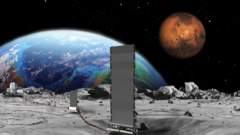In a bold move, NASA is accelerating plans to deploy a nuclear reactor on the Moon by 2030, as reported by U.S. media outlets. This initiative seeks to support the establishment of a permanent human presence on the lunar surface, amidst a backdrop of international competition from countries like China and Russia, who also harbor similar ambitions.
Reports indicate that Sean Duffy, the acting administrator of NASA, has urged for rapid advancements in this technology to ensure a sustainable lunar economy, particularly for energy generation that could eventually extend to Mars. According to him, the agency is in urgent need of proposals from commercial firms to design a reactor capable of producing a minimum of 100 kilowatts of power, a relatively modest output compared to traditional energy sources.
While the concept of utilizing nuclear energy on the Moon isn't new—NASA previously awarded contracts for reactor designs in 2022—the urgency of this timetable raises eyebrows. Many experts express concerns regarding whether financial limitations resulting from significant budget cuts will hamper progress. There’s also a widespread fear that national interests may overshadow scientific exploration as nations race to lay claim to lunar resources.
Experts assert that nuclear energy is critical due to the unique conditions on the Moon, where a single lunar day encompasses two weeks of sunlight followed by two weeks of darkness. Dr. Sungwoo Lim of the University of Surrey asserts that solar energy alone will not suffice for a lunar habitat, making nuclear energy a necessary fallback.
However, concerns over safety linger, especially regarding the potential risks involved in launching radioactive materials into space. Despite these worries, some specialists believe that with adequate investment and commitment to the Artemis program, the goal could be achievable.
NASA's plans come as the once collaborative spirit of lunar exploration dwindles, with nationalistic ambitions creeping into proposals. Duffy's comments referencing a potential "keep-out zone" established by rival nations underline a rising tension in space exploration and governance, akin to the historical space race of the mid-20th century.
In the larger context, the intended implementation of nuclear reactors raises crucial questions about lunar ownership, safety zones, and sustainability of human activities on the Moon. As the timeline for NASA's Artemis missions progresses, the urgency for political and financial backing becomes ever more critical in shaping humanity's future journeys into outer space.
Reports indicate that Sean Duffy, the acting administrator of NASA, has urged for rapid advancements in this technology to ensure a sustainable lunar economy, particularly for energy generation that could eventually extend to Mars. According to him, the agency is in urgent need of proposals from commercial firms to design a reactor capable of producing a minimum of 100 kilowatts of power, a relatively modest output compared to traditional energy sources.
While the concept of utilizing nuclear energy on the Moon isn't new—NASA previously awarded contracts for reactor designs in 2022—the urgency of this timetable raises eyebrows. Many experts express concerns regarding whether financial limitations resulting from significant budget cuts will hamper progress. There’s also a widespread fear that national interests may overshadow scientific exploration as nations race to lay claim to lunar resources.
Experts assert that nuclear energy is critical due to the unique conditions on the Moon, where a single lunar day encompasses two weeks of sunlight followed by two weeks of darkness. Dr. Sungwoo Lim of the University of Surrey asserts that solar energy alone will not suffice for a lunar habitat, making nuclear energy a necessary fallback.
However, concerns over safety linger, especially regarding the potential risks involved in launching radioactive materials into space. Despite these worries, some specialists believe that with adequate investment and commitment to the Artemis program, the goal could be achievable.
NASA's plans come as the once collaborative spirit of lunar exploration dwindles, with nationalistic ambitions creeping into proposals. Duffy's comments referencing a potential "keep-out zone" established by rival nations underline a rising tension in space exploration and governance, akin to the historical space race of the mid-20th century.
In the larger context, the intended implementation of nuclear reactors raises crucial questions about lunar ownership, safety zones, and sustainability of human activities on the Moon. As the timeline for NASA's Artemis missions progresses, the urgency for political and financial backing becomes ever more critical in shaping humanity's future journeys into outer space.
















